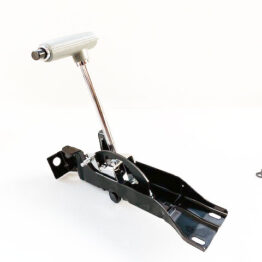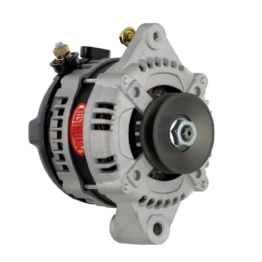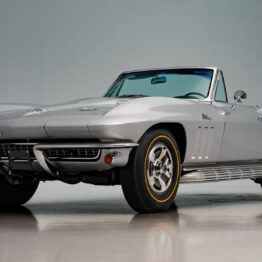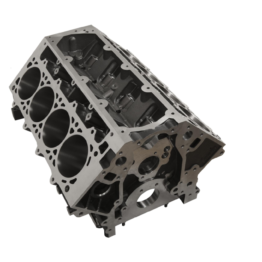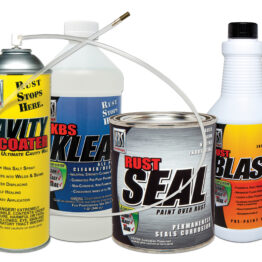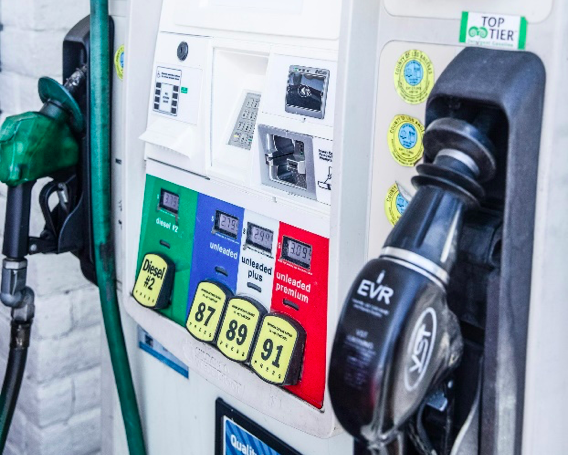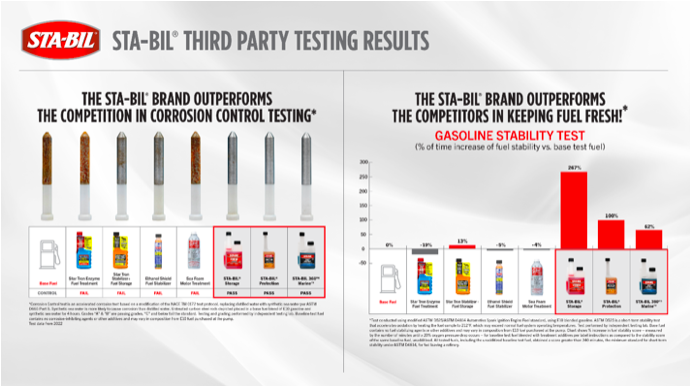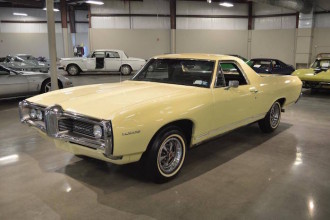Stabilizing fuel is not a new practice but is often forgotten about until it is too late and your run into fuel related issues. Fuel stabilization prevents oxidation, which allows fuel to stay fresher for a longer period. Gasoline from the refinery begins to break down in as little as 30 days, once gasoline begins to degrade there is nothing that can bring the light ends of the fuel back leaving you with bad fuel and an engine that is going to run rough or not at all. Below are a few questions that often get asked about why fuel stabilization is necessary.
WHY DOES GASOLINE GO BAD?
Gasoline degrades over time due to the natural process of oxidation and evaporation. Oxidation will occur when the fuel is exposed to oxygen, which leads to the formation of peroxides and aldehydes which is a fancy way of saying the fuel is degrading and will impact overall engine performance. Evaporation of hydrocarbons, such aspentane and hexane may also be taking place decreasing the fuels octane rating. Last but certainly not least most of todays gasoline is blended with ethanol, which is naturally hygroscopic, meaning it attracts and absorbs water from the atmosphere. This can lead to phase separation which can cause gum and varnish buildup in carburetor jets, fuel injectors, fuel filters, and other areas of the vehicles fuel system causing fuel related issues.
There are many factors that determine a fuels shelf life, including fuel type, fuel quality, and storage conditions. The general “good by date” of fuel is 30 days, but can be shorter depending on storage conditions. Gasoline should be stored in a cool, dry, dark place with minimal exposure to oxygen. To maintain fuel potency, follow the steps above and use a fuel stabilizer to prevent the negative effects of fuel degradation.
HOW QUICKLY DOES GASOLINE GO BAD?
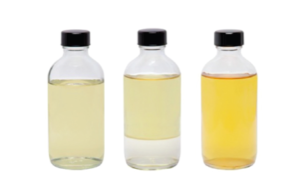
Fresh gasoline is usually clear or straw-colored. It may also
have a slight yellow or amber tint. Center: Phase separation in
gasoline is caused when water, which is heavier than gasoline,
sinks to the bottom of the gasoline container. Right: The amber
hue of gasoline gets darker as it becomes stale or “bad.”
There are many factors that determine a fuels shelf life, including fuel type, fuel quality, and storage conditions. The general “good by date” of fuel is 30 days, but can be shorter depending on storage conditions. Gasoline should be stored in a cool, dry, dark place with minimal exposure to oxygen. To maintain fuel potency, follow the steps above and use a fuel stabilizer to prevent the negative effects of fuel degradation.
WHAT IS A FUEL STABILIZER?
Fuel Stabilizers such as STA-BIL is a chemical additive designed to prevent gasoline from going bad. They work by absorbing moisture and other impurities that accelerate the chemical breakdown of gasoline. This will extend the usable fuel life of the fuel and prevent gum, varnish, and water buildup. Not all fuel stabilizers are created equally, so make sure to recommend a quality product to your customers.
DO FUEL STABILIZERS ACTUALLY WORK?
Fuel stabilizers are chemical additives that are added to fuel to prevent the natural processes of oxidation and evaporation, which lead to the degradation of fuel quality. These additives have been shown to be effective in preventing fuel from going bad, but it is important to note that they have limitations. Fuel stabilizers are not able to improve the quality of bad gasoline and cannot restore lost potency once it has degraded.
They are best used as a preventive measure, prior to storing a vehicle or equipment or in situations where driving habits have changed, such as seasonal usage of the vehicle or equipment. As a general principle, the less a vehicle or equipment is driven, the more benefit can be obtained from using fuel stabilizers. It is also important to note that once gasoline has gone bad, there is no “magic cure or additive that can restore its lost potency. Therefore, it is essential to choose a quality stabilizer, with appropriate formulation and certifications, and follow the manufacturer’s instructions for optimal results.
COMMON MISCONCEPTIONS:
–Gasoline doesn’t go bad.
-Think of gasoline like milk. You buy it at the grocery store, you bring it home it has an expiration date. Just like milk, so does your gasoline. There are just so many factors that go into it that it makes it hard to put a specific date as to when it begins degrading.
-If there is some bad gas in my tank, I can mix it with good gas and it will be fine.
-Again, think of milk. If you have bad milk and you pour it in your cereal, then mix in some good milk are you going to want to eat it? We hope not! Your engine doesn’t want to eat bad gas either. Mixing good and bad fuel will still cause issues with your engine.
-My engine runs on old gas all the time; you are saying it begins to go bad in as little as 30 days?
-When we say “gas begins to go bad in as little as 30 days” doesn’t mean your engine is no longer going to run. If it does run your engine is not running as efficient as it should be and over time is going to have more carbon deposits, gum, and varnish buildup inside your engine that could have been avoided to help it last longer and run healthier.
-Fuel additives are snake oil.
-As a company that formulates, manufactures, and distributes these items under various brands and OEMs we agree with this comment at some level. Unfortunately, there are a lot of companies in the fuel additive space that are selling inferior products to customers. We are a 90+ year old family-owned company and our owners will not allow us to make claims our products won’t do and that are also backed by 3rd party test data.
-Running my engine out of gas for storage is better than using an additive like STA-BIL. 
-OEMs and ourselves have done testing and the issue with running your tank dry is it leaves room in the entire system for moisture to form. When moisture forms you can get rust and corrosion throughout your engine. Another issue is all the rubber components can begin to dry out. Best practice is a fuel tank with fresh gasoline 95% full with a fuel stabilizer.
-Why does STA-BIL have a red, orange, and blue version of a stabilizer?
-The red STA-BIL STORAGE product is strictly a fuel stabilizer to use when you know something is going to be sitting idle for a long period of time. Generators, spare gas cans, collector cars. The orange STA-BIL 360 Protection is for everyday use. P.E.A fuel system cleaners to clean the system, corrosion additives, and water removers increase power and efficiency while also protecting the fuel system. The blue STA-BIL 360 Marine additive is specifically designed for marine use to negate the effects of ethanol blended fuels by cleaning the fuel system, removing water, eliminating corrosion, and stabilizing fuel. There is a STA-BIL product for every fuel related issue.
-Non-Ethanol blended fuel doesn’t go bad, no need for an additive.
-Non-ethanol fuel is highly recommended in small engines, but the gasoline does still degrade in about 90 days vs ethanol fuel in as little as 30 days. STA-BIL first came out with a fuel stabilizer in 1958 long before ethanol blended fuels were a thing as there was a need then and an even larger need for a stabilizer today. So, yes you still need a stabilizer with non-ethanol fuels.
-I tried a fuel stabilizer and it didn’t work.
– We hear this one once in awhile at events and shows and usually it comes down to this answer when we ask questions. We will ask “tell us your process?” They respond with “I had the gas in my car or gas can and I added a fuel stabilizer in November and when I went to use my equipment in the spring the gas wouldn’t work.” The next thing we ask is “the fuel you added the stabilizer too… when did you get it?” The answer is usually “I filled my gas can in the spring.” This is common. Adding a stabilizer to your gasoline is going to keep the gas as fresh as when you add it, which is why we recommend doing it at the pump. Adding a stabilizer months later when the gas is already degrading is not going to make fuel fresh again and the stabilizer will not work as it is intended.

Rick Seitz is the owner and founder of AutoCentric Media, the parent company to Timeless MuscleCar Magazine, and has a true love and passion for all vehicles. When he isn’t tuning, testing, or competing with the magazine’s current crop of project vehicles, he’s busy tinkering and planning the next round modifications for his own cars.


